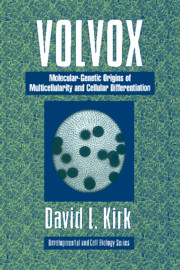 Volvox
Volvox Book contents
- Frontmatter
- Contents
- Preface
- Prologue
- 1 Introduction
- 2 The Volvocales: Many Multicellular Innovations
- 3 Ecological Factors Fostering the Evolution of Volvox
- 4 Cytological Features Fostering the Evolution of Volvox
- 5 Volvox carteri: A Rosetta Stone for Deciphering the Origins of Cytodifferentiation
- 6 Mutational Analysis of the V. carteri Developmental Program
- 7 Molecular Analysis of V. carteri Genes and Development
- Epilogue
- References
- Index
5 - Volvox carteri: A Rosetta Stone for Deciphering the Origins of Cytodifferentiation
Published online by Cambridge University Press: 16 December 2009
- Frontmatter
- Contents
- Preface
- Prologue
- 1 Introduction
- 2 The Volvocales: Many Multicellular Innovations
- 3 Ecological Factors Fostering the Evolution of Volvox
- 4 Cytological Features Fostering the Evolution of Volvox
- 5 Volvox carteri: A Rosetta Stone for Deciphering the Origins of Cytodifferentiation
- 6 Mutational Analysis of the V. carteri Developmental Program
- 7 Molecular Analysis of V. carteri Genes and Development
- Epilogue
- References
- Index
Summary
Progress in understanding a biological process and its control is dependent upon, and at the same time limited by, the nature of the organism which provides the system under investigation. … The genus Volvox offers a variety of species which may serve in varying ways as experimental material for studies in differentiation of a simple multicellular organism with only two kinds of cells, somatic and reproductive. … Volvox carteri f. nagariensis has been more thoroughly investigated than other species and has been shown to possess an unusual combination of characteristics which make it especially adapted to [such] studies.
Starr (1970a)The foregoing statement is as valid now as it was when it was written 27 years ago. Modern studies of Volvox biology began in Richard Starr's laboratory in the 1960s, when William Darden, then a graduate student, demonstrated that axenic cultures of Volvox aureus could be maintained indefinitely in a chemically defined medium that had been developed a few years earlier for culturing other types of algae (Provasoli & Pintner 1959). In such cultures he was able to observe and study all stages in the asexual and sexual life history of V. aureus under controlled conditions (Darden 1966). Later, he and his associates would use this culture system to examine a variety of aspects of V. aureus biology (Darden 1968, 1970, 1971, 1973a,b; 1980; Deason et al. 1969; Darden & Sayers 1969, 1971; Ely & Darden 1972; Tucker & Darden 1972).
- Type
- Chapter
- Information
- VolvoxA Search for the Molecular and Genetic Origins of Multicellularity and Cellular Differentiation, pp. 109 - 217Publisher: Cambridge University PressPrint publication year: 1997


